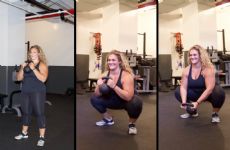|
Have you ever heard a woman say, "I can't lift weights. I don't want to get bulky." Or how about, "I don't want to gain muscle. I just want to tone the muscle I already have." These are just a couple of the common responses I hear when I suggest strength training to women who are interested in getting in better shape. Sadly, there are many myths that women believe about muscles and strength training. Although we've seen a bit of a paradigm shift happening the past few years in which more women are making their way into the weight room, there are still just a few myths that won't die, and I'm going to bust them now. Myth #1: Strength Training Makes Women Bulky There's probably not a myth in the industry that drives fitness professionals crazier than this one, but before I dive headfirst into busting this myth, let me say this: Whether or not this is true all depends on your personal definition of bulky. You see, my friend Leigh Peele conducted a poll several years ago asking thousands of women about which Hollywood celebrities they thought were "bulky." Their answer? Jessica Biel. Obviously every person is entitled to his/her own opinion, but I have a very hard time seeing how anyone could view Jessica Biel as "bulky" when she is (reportedly) 5'7" and 121 pounds and likely a size 2. So I'll say this, if you find Jessica Biel to be "bulky" then yes, in your personal opinion, you might find that strength training makes you "bulky," despite the fact that 95% of my female clients lose 1-2 clothing sizes within 3 months of starting to strength train. Now if you think of a female bodybuilder when you think of the word "bulky" then I can tell you with absolute certainty that that is not going to happen to your body. Women don't produce enough testosterone to add significant amounts of muscle mass quickly or easily. Muscle mass takes years and years of hard work to build, and many female bodybuilders choose to enhance themselves chemically because they have such a hard time gaining muscle mass. If you start strength training and feel "bulky," it's imperative that you take a deeper look into your nutrition, as it's almost always excess body fat that makes a woman feel bulky, not excess muscle mass. Strength training is fantastic for revving up your metabolism and it can definitely make you hungrier because more muscle means you're burning more calories each day. Often women will start eating a lot more when they start strength training. You just have to make sure that you're reaching for the correct foods like lean protein, vegetables, healthy fats, and good carbs because making the wrong food choices will lead your farther away from your goal. Myth #2: When Strength Training, Women Should Lift a High Number of Reps First and foremost, let's clear this up: Strength training doesn't always mean lifting weights. Strength training can be any type of movement that imposes an increasing demand on your muscles and/or central nervous system, causing an adaptation. So basically, you apply a stress your muscles, and then your body tears down muscle tissue and rebuilds it bigger and stronger than before, or it increases the efficiency of your neural pathways so you can recruit more muscle fibers more effectively in the future. Simply put, your body figures out how to make the task you just performed easier in case you have to perform it again in the future. In the beginning, simply moving and manipulating your own body weight can cause a positive adaptation within your body in terms of getting stronger and adding muscle mass. When you do start to lift more than just your body weight, of course you should start lighter so that you can learn how to do the movement properly, but that light weight should still feel challenging. The amount of resistance that you're lifting should feel challenging to you, and you shouldn't be able to do it for more than 15 reps. In fact, in most cases, you shouldn't be able to lift the weight you're lifting for more than 8-12 reps (there are occasional exceptions) if you really want the benefits of strength training. Remember how I mentioned above that when you lift weights you're imposing an increasing demand on your body and causing an adaptation? Well if you're lifting a weight that's not challenging to you, you are simply not signaling your body to change at all, so there's not much of a purpose to it. Make sure you're always choosing a weight that's challenging for your current ability level in order to get the best results from strength training. Myth #3: Strength Training Can "Tone" or Spot Reduce Body Fat in a Specific Area I hate to break your hearts ladies, but "toning" doesn't really exist. Well, you can increase the "tone" of a muscle to a slight degree, but it's not what most of us think it is. However, to be fair, when most women say that they want to looked "toned," they generally mean that they want to lose body fat, and have a firmer and tighter body with a lightly muscled appearance, and that is definitely possible. Remember: "I don't want to gain any muscle. I just want to tone the muscle I already have."? That's not really possible. Increasing the look of one's muscle tone involves losing body fat, and usually increasing muscle mass. That is what will give you a more tight and toned appearance. In terms of spot-reducing, this is another pervasive myth. Doing a million crunches simply will not spot-reduce the fat on your midsection. When you reduce your body fat levels, your body will choose where it wants to lose fat from first. For some people, it's their "problem area" simply because that's where they carry the most fat, so it's most noticeable. For others, their "problem areas" are particularly stubborn, and they lose everywhere else first. Unfortunately, you can't directly control this with weight training, although if you add lean mass to a particular area, it can give you the appearance of looking tighter and firmer, even if you haven't lose body fat there yet. So no, you can't technically "tone" or spot-reduce, but you can use strength training combined with sound nutrition and intelligent cardio to get the lean, toned body you desire. Myth #4: Weight Lifting Is Dangerous. In regards to this myth, I have to quote my good friend Bret Contreras here: "If you think lifting weights is dangerous, try being weak. Being weak is dangerous." As with any new activity, there is some level of inherent danger. The same would be true with rock climbing, cycling, running, or even yoga. But it's very simple to drastically reduce your risk of injury with strength training, since a good program would balance out your body for optimal strength and power, thereby decreasing your risk of injury in other activities. What are some simple ways to reduce your risk of injury and bulletproof your body when strength training?
Saying that you can transform your fat cells into muscle cells is like saying that you can transform wood into metal. They are two totally and completely different things, and they cannot change form back and forth. Of course as we discussed above, you can lose body fat and gain muscle, and transform the look of your body. But muscle will not turn into fat, and the inverse (another common myth you'll hear) is also true: Muscle will not turn into fat when you stop working out. You might lose strength and muscle mass and/or gain body fat when your workouts stop, but fat and muscle are and will always be separate things in your body. If you're interested in learning more about how you can lose body fat, and gain a tighter, firmer, and more toned appearance while learning how to perform exercises correctly, check out The Modern Woman's Guide To Strength Training from Girls Gone Strong, which features three 16-week training programs that are suitable for women of all ability levels, more than 80 minutes of HD video demonstrating exactly how to perform over 70 exercises, and more.  About the Author About the AuthorMolly Galbraith is a strength coach and co-founder of J&M Strength and Conditioning, a rapidly expanding, private gym in Lexington, Kentucky, for professional athletes and the general public alike. She is also co-founder of the wildly popular Girls Gone Strong group, a movement dedicated to changing the way women train. Her mission is to, ''Help women give themselves grace and compassion when it comes to their bodies, and to help them discover and accept what their best body looks like, with minimal time and effort.'' She has also been an expert contributor to magazines like Oxygen and Experience Life. No stranger to the gym herself, she has competed in both figure and powerlifting and her best lifts include a 275-lb. squat, a 165-lb. bench press, and a 341-lb. deadlift. You can find out more about Molly by visiting her website, and you can keep up with her latest adventures on Facebook and Twitter. |
Related Entries
More From SparkPeople
|






















